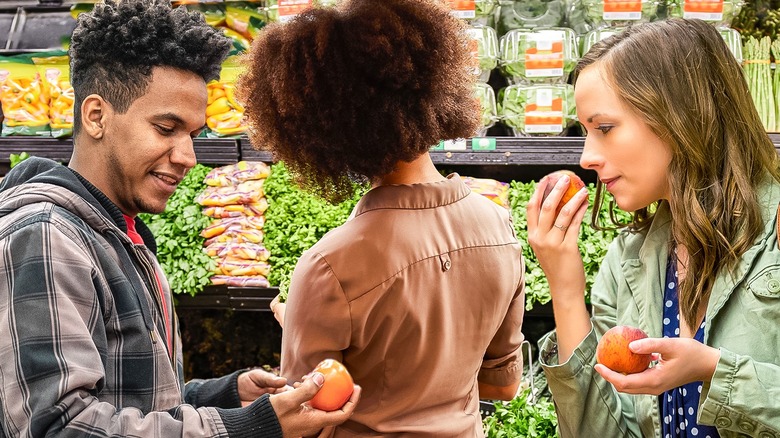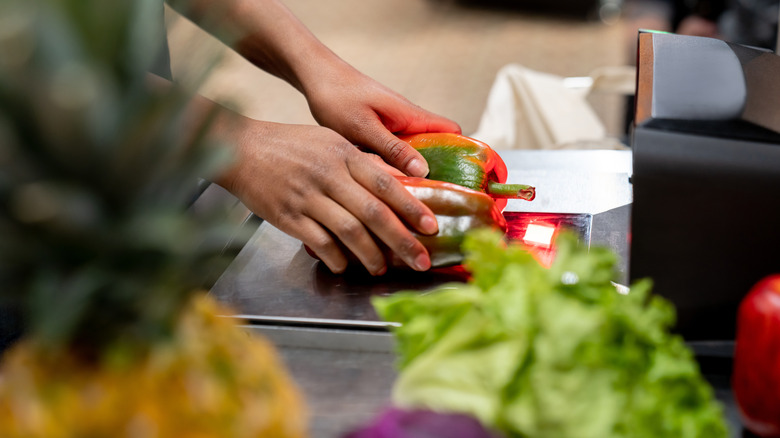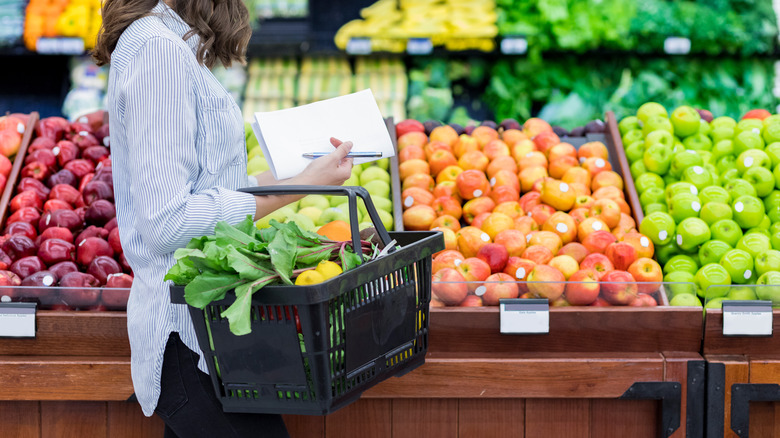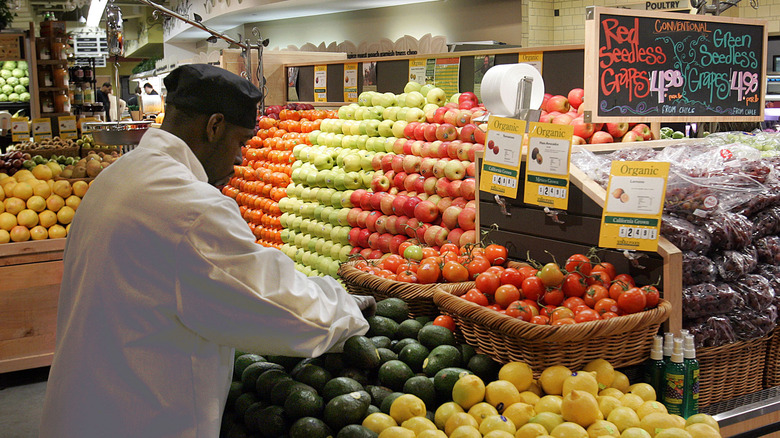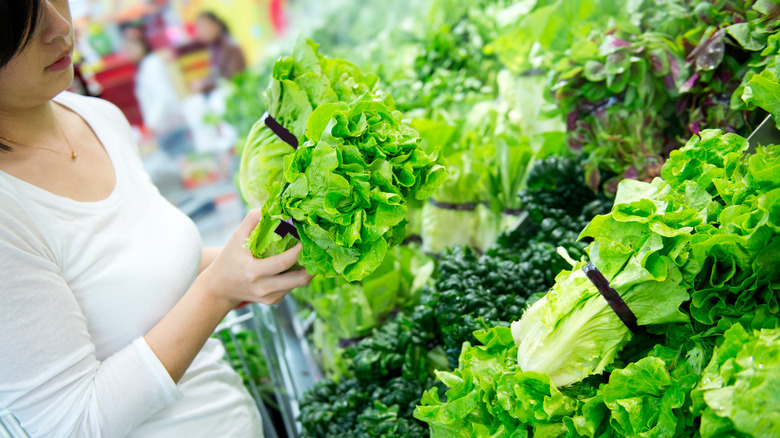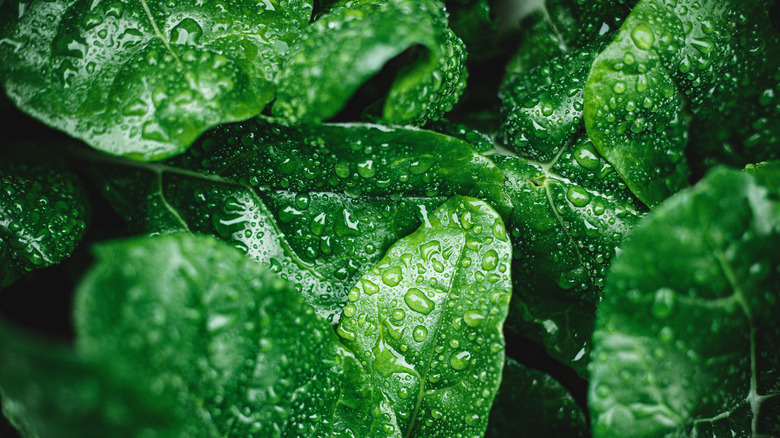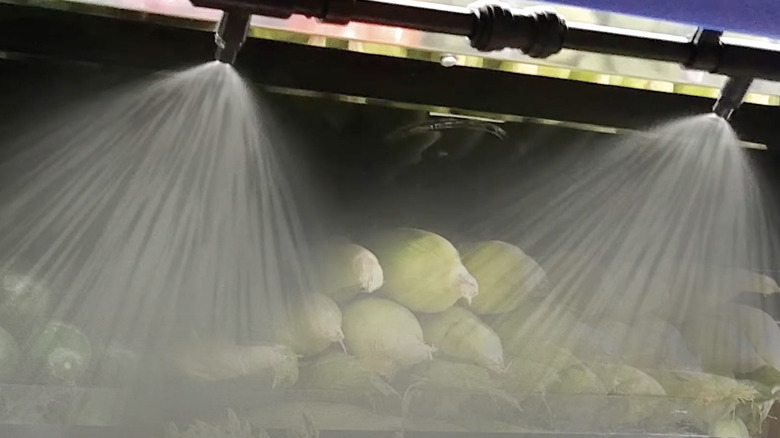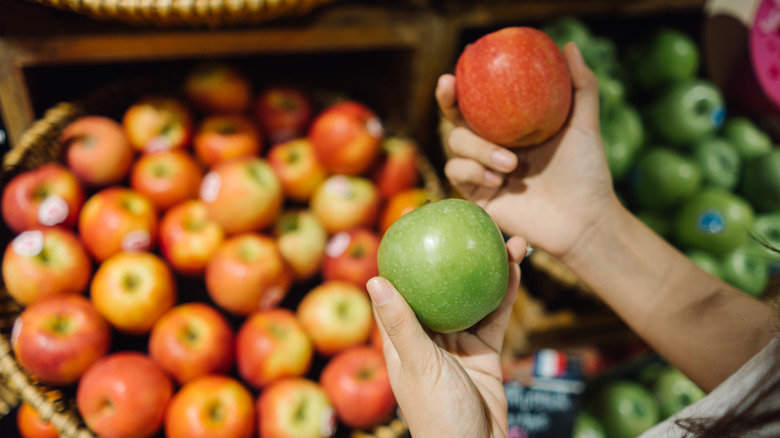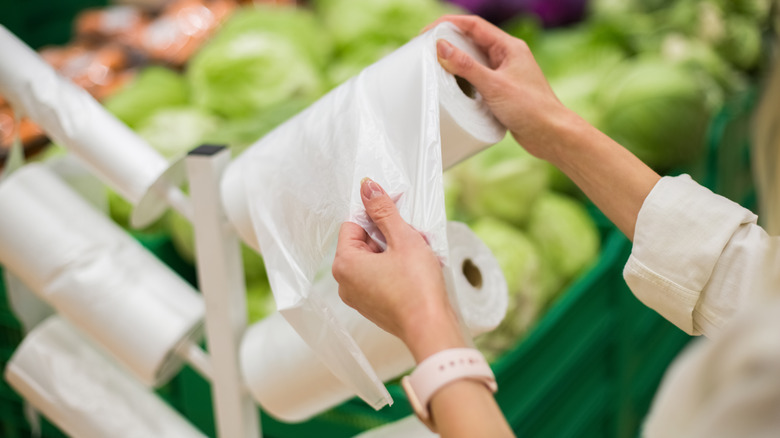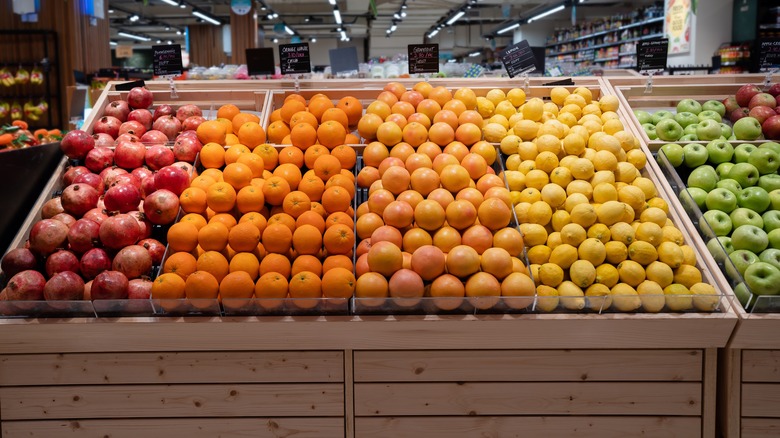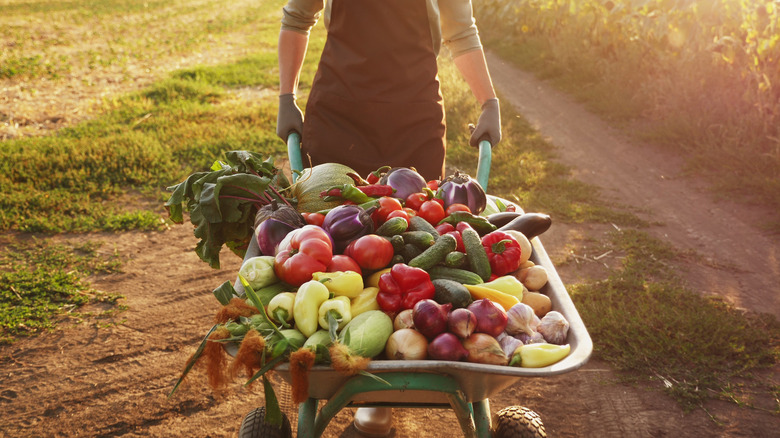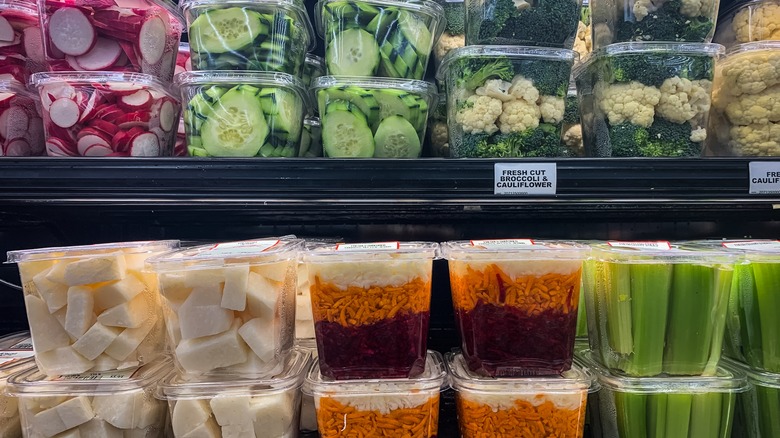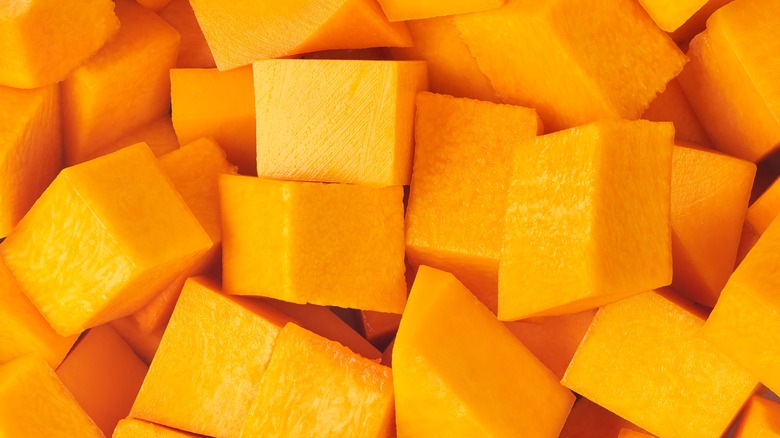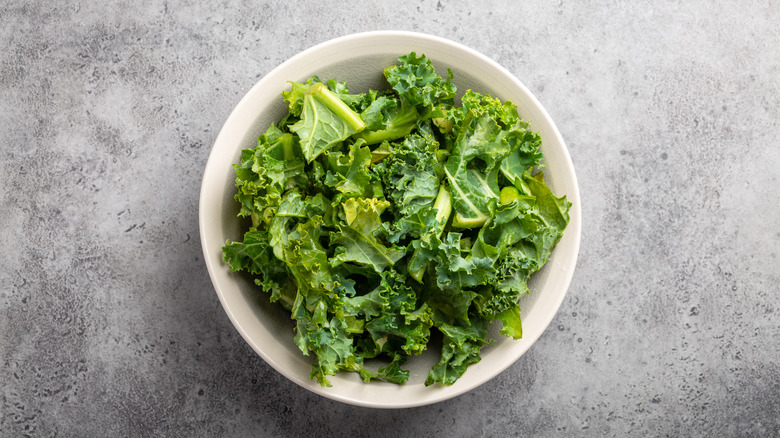13 Things To Know When Buying Produce At The Grocery Store
In a perfect world, purchasing quality produce would be as easy as simply stopping by your local grocery store and grabbing the first thing you see. There are some important things to take into consideration though. A vibrant red apple is not always a sign of ripeness, and a spray of mist does not always mean it's fresh. Picking ripe produce is only part of the challenge. Unlike boxed foods, fresh fruits and veggies do not come with an ingredient list or expiration date. When it comes to quality, the time of day that you go shopping and the type of grocery store you choose can make all the difference.
Thankfully, the climate is ripe for learning ways to pick better produce. According to a study done by the U.S. Department of Agriculture, adding more fresh vegetables to your diet will actually improve your overall happiness. In fact, the NHS says that you should eat at least five portions of either fruit or veggies each day to reduce the chances of serious health issues — a portion equals 80 grams (or ¼ cup). However, in the U.S., only 1 in 10 adults consume the recommended daily amount of produce. Don't let those statistics get you down though, it's never too late to start incorporating more fruits and veggies into your diet. Here are a few things to keep in mind next time you buy produce at the grocery store.
The cost of produce is increasing
Your pockets have probably felt the effect of increasingly expensive groceries. There are many factors — from supply chain disruption to climate change and inflation. According to the USDA, the overall cost of store-bought food is expected to increase by 5.8% in 2023. In 2024, the increase will likely decelerate but prices are expected to remain steady. One way to save money is by purchasing produce that's in season.
In-season fruits and veggies are tastier, more nutritious, and cost less to harvest and transport, whereas out-of-season produce must be shipped from far-away places. It's also a more sustainable way to buy produce. Seasonal produce is shipped across shorter distances, which means that fewer emissions are released into the air. A great way to learn how to spot indicators of ripeness and quality is by looking at a seasonal produce guide. For example, pineapples and mushrooms are best in spring, but summer is ideal for watermelon and corn.
Choose the stores with the best produce
From the layout to how it's displayed, the produce section is an integral part of the grocery shopping experience. Unfortunately, not all produce sections are created equal. There's a noticeable difference between the Roma tomatoes you find at Ralphs and the organic beauties at Sprouts. Along with the grocery store chain, the neighborhood it's located in can sometimes determine the quality of produce you're going to get and the available selection. Usual suspects like broccoli, Brussels sprouts, gala apples, and bananas are pretty widespread, but not every grocery store carries things like jackfruit, bittermelon, or purslane.
For example, Target offers a limited selection that's often pre-packaged and lower quality compared with Trader Joe's, which, while also pre-packaged, is of higher quality and comes with a wider selection. Ideally, you want to choose a grocery store that sources its produce locally. Local produce is fresher, more sustainable, and supports nearby farmers. Popular chains like Whole Foods, Gelson's, and Lassens all get their fruits and veggies locally. That said, always choose based on what you can afford.
The oldest produce is in the front
A common rule that all grocery stores follow is FIFO, otherwise known as "first in, first out." It's a lesser-known truth about the grocery store produce section that involves rotating older food to the front while stocking the freshest toward the back. That means that next time you see someone reaching deep into the jungle of leafy greens to extract a fresh one, save the side-eye because they're actually onto something. Whether you grab it from the front or the back, you don't have to get your salad in a bunch. The shelf life typically allows more than enough time.
For produce stocked at room temperature, there's a benefit to picking from the bottom as well. According to the University Of Maryland Extension, plants produce a gas called ethylene that helps fruits and veggies ripen. When bunched together, the combined exposure to ethylene is multiplied, quickening the process. That's why produce that's stored at the bottom of the pile is likely to be more ripe than those on top.
Make sure to inspect the produce
When inspecting produce at the store, knowing what to look for is important. Avoid leafy greens such as kale, chard, arugula, and others if they're wilted and rubbery — it's a sign of dehydration. Grocery stores use misters to help keep produce hydrated, at least until it succumbs to its shelf life. When in doubt, always go for leafy greens with a firm texture that pops with color. Watch out for yellow, brown, and black discoloration. You can cut around brown spots,but yellow leaves are a sign of aging. Meanwhile, black spots come from harmless microbes but are visually unappealing.
If you prefer bagged leafy greens, check the expiration date and shake each bag for icky clumps. Slimy leafy bunches can spoil the whole bag. Figuring out how to spot quality can be overwhelming with so many varieties of produce in the world. Luckily, many fruits and vegetables generally have similar quality indicators, and at the very least, you can learn how to inspect the most commonly available produce. For example, when checking for tomato ripeness, the flesh should give a bit when pressed in and have a vibrant and blemish-free appearance. If you put your nose to the stem side, it should smell earthy and sweet. Garlic is another popular ingredient. Pick bulbs that are firm and tight, without soft spots or green sprouts, and range in color from white to off-white. Stepping your inspection game up will save you time — and money — and make for more delicious meals.
Misters add weight to produce
The rumbling above the fresh produce section carries all of the theatrics of a staged production. Misters are simultaneously a warning to step back and an alert that the produce is fresh and ready. The mist system is used to irrigate vegetables that cannot be frozen or stored at room temperature — at least that's what we're expected to believe. While the spritz of water helps rehydrate some greens, there's actually a sneaky yet clever reason why grocery stores spray produce. Although vegetables do shrink when dehydrated, misting vegetables is mostly a marketing ploy. There's just something alluring about seeing glistening droplets of water on produce that makes us associate it with freshness.
We're here to tell you that grocery stores have duped you for years because misters do not make veggies fresher. Misters do, in fact, serve ulterior motives, they add weight to produce. The heavier the produce, the more it will cost at checkout, which is good news for grocery stores. To give you an example, a 2016 study done by Miatech found that the weight of a non-misted head of broccoli was 4% less due to shrinkage, while a misted one actually gained an additional 5% of weight.
Unclean misters can contaminate produce
Aside from making produce look more attractive, hydrated, and adding more weight to them, misters aren't all spritz and giggles. Picture this: You're just going about your regular grocery store visit, checking things off your to-do list, when the vibrant green glow of leafy goodness catches your eye. Little did you know, those shiny bubbles of water might be filled with harmful bacteria. When misters aren't cleaned and maintained, they can quickly become contaminated.
According to Total Water, the mister system is made up of plastic tubing that sits idle when not in use. That's prime conditions for cultivating bacteria growth. We're not saying that you should steer clear of misted produce because, at the end of the day, we'd like to hope that grocery outlets take cleaning and the health of their customer base seriously. But, just to err on the side of caution, it's good to know these things. According to the Legionella Control, misters and other aerosol-based water systems are inherently at risk of Legionella bacteria contamination. A major Legionella breakout during the 1990s was found to have originated from an unclean misting system.
Squeezing produce can damage it
An important part of purchasing quality produce is having to physically pick it up and feel it. Depending on what type of fruit or vegetable you're inspecting, its toughness or softness can be an indicator of whether it's unripe, ripe, or starting to expire. When checking for firmness and texture, it's normal for people to squeeze produce, but that can damage fruit if you aren't careful. It happens frequently throughout the day, which subsequently leads to bruises.
Damaged food is considered "non-sellable," as supermarkets prefer offering perfect-looking produce. According to Recycle Track Systems, grocery stores throw away around 30% of the food they have in stock. That's why we always recommend gentle handling when testing fruit for ripeness. Take apples as an example: You want them to be firm and bruise-free. You can easily check for that by looking and carefully applying pressure. Fruits such as avocados and oranges are very easy to puncture when ripe. Unlike apples, oranges can be ripe whether bright-colored or greenish-hued. The indicators to look for are finely textured skin and weightiness — the heavier it is, the more juice it's filled with. As previously mentioned, check seasonal produce guides to find out whether or not something is ripe.
Plastic grocery bags make produce go bad
It's surprising to find out that you've been going about something the wrong way, especially when you've been doing it for years. You'll probably be taken aback to learn that plastic grocery bags are bad for produce. To be clear, they're perfectly fine for temporary transportation to your home but should be removed and discarded upon arrival. Produce actually lasts longer when it's exposed to oxygen. Plants use oxygen for cellular respiration during photosynthesis. It allows them to break down and consume the sugars that they need. Simply put, storing produce in plastic bags is akin to suffocation. Produce requires a balance of humidity and airflow to stay fresh for longer periods.
Pre-packed produce that's ventilated is an exception. Tender vegetables are especially susceptible to spoiling when stored in airtight containers. Enclosed containers also increase ethylene exposure, which speeds up the ripening process. Looser options — such as muslin, cotton, or linen bags — are preferable.
Store-bought produce is freshest right after delivery
If freshness is at the top of your list, but you don't have any farmers markets nearby, there's another clever way to secure the goods: Learn the produce delivery schedule of your local supermarket. Knowing when produce is delivered will allow you to purchase when it's as fresh as possible. While most major chains restock daily, smaller ones may only restock twice a week. Every store has its own schedule, but delivery days typically land on Tuesdays and Fridays — in the morning or evening. That's why you should avoid buying fresh produce during the middle of the day. When in doubt, simply ask someone who works there. Chefs who run professional kitchens ask all the time.
Produce begins aging immediately after it's harvested, which means that by the time it makes it to grocery stores, the freshness window has already begun to close. On top of that, out-of-season produce often travels thousands of miles before reaching its destination. We recommend consuming produce within three days of purchasing it. The sooner you eat them, the fresher and more delicious they will be. Storing fruits and veggies for later is perfectly fine, too, but it just won't yield the same nutritious results.
Local doesn't necessarily mean it's from your city
As with any business, supermarkets employ clever marketing tactics to attract customers. The word "local" doesn't always mean local at grocery stores. Produce that's labeled as such can actually be from a city that's hundreds of miles away. In Sacramento and surrounding cities, anything that's harvested within 500 miles is considered "local" by Sprouts Farmers Market. According to ABC10, Safeway has a totally different definition: Anything grown in California is considered local. Sourcing its produce within a small 50-mile radius, Raley's in Northern California sticks closer to the farmers market definition of local. The distance varies from location to location and from chain to chain.
Another way to get an idea of how far produce has traveled is to check the origin location on the sticker label. Those tiny stickers can let you know the state or region that fruits and vegetables come from, and if they were grown traditionally or organically. To ensure the best quality, pick produce that's sourced from the locations closest to you. The more local the produce, the more flavorful, nutritious, and sustainable.
Check pre-cut produce for price and freshness
In the everyday hustle and bustle of life, saving time is everything. The day doesn't always leave room for chopping up ingredients, especially if a recipe requires a lot of prep work. Luckily, grocery stores offer pre-cut produce that's packaged and pretty. Why go through the nerve-wracking experience that comes from trying to make perfect julienne-cut veggies, when you can just buy them in a bag? Aside from the aforementioned pros, there are some cons too. Pre-cut produce is not as nutritious as uncut fresh or frozen. It's also more expensive.
Before buying pre-cut produce, it's important to check for freshness and how much it costs. Foods like coconut, pineapple, and butternut squash hold up well when pre-cut. Whereas, berries and citrus fruits are prone to becoming mushy. When buying pre-cut fruit in particular, you cannot tell whether it's ripe through the bag or plastic container. Make sure you're not paying for produce that was cut more than two days ago. Ideally, you want the ones that were chopped up the same day.
Avoid extra prep with pre-cut butternut squash
There are fruits and vegetables that one could argue are pointless to pre-cut, but butternut squash is definitely not one of them. Anyone who's been tasked with the unfortunate responsibility of preparing one will tell you that it can make even the most experienced knife-wielder nervous. The best word to describe it is "intimidating." Its outer skin, which is more like a hardened shell, feels as if your knife's edge will chip against it. If you aren't careful, all it takes is a single slip to end up with a serious injury. Luckily, if you buy pre-cut butternut squash, you can avoid the hassle, extended prep time, and potential trip to the hospital.
When it comes to pre-chopped cubes (which, at the store, should be displayed in a refrigerator or surrounded by ice), inspect the package to make sure the chopped squash doesn't have a white hue on the exterior, which could mean they're losing moisture and nutritional value.
Pre-cut kale has already begun to decompose
Leafy greens, like kale, are best enjoyed right after they're chopped — that's when the fresh-timer starts ticking and one of several reasons why fresh kale is superior. It is super important to inspect bagged salad mixes and leafy greens before buying them. Sealed plastic bags also contribute to a lower shelf life. Leafy greens tend to brush together in plastic bags and bruise, which causes them to spoil more quickly.
Pre-chopped kale that's sold in plastic containers is actually a better alternative to plastic bags. We recommend consuming them within six days of purchase. After that, the nutrients will begin decreasing. Whole kale leaves are always preferable to chopped ones and taste more flavorful, too. With that said, when there is no time to prepare ingredients, pre-chopped kale is the best way to go. Just make sure to use it sooner than later.
